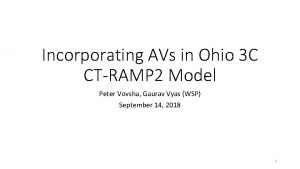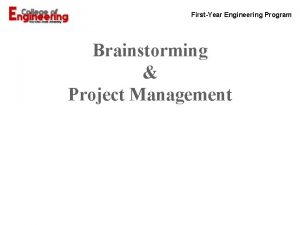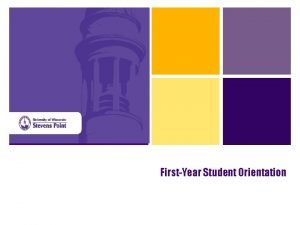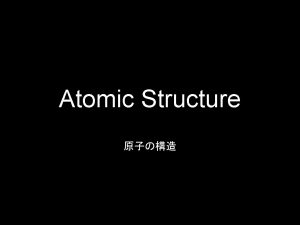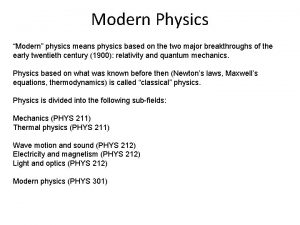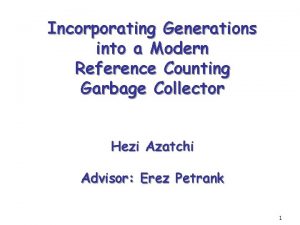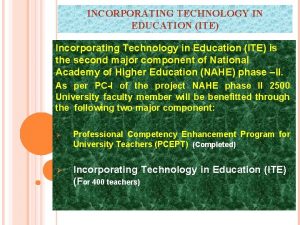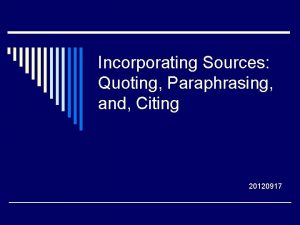Incorporating Modern Physics into the FirstYear Introductory Physics













- Slides: 13

Incorporating Modern Physics into the First-Year Introductory Physics Course Sequence Duane Deardorff, Alice Churukian, Reyco Henning Dept. of Physics and Astronomy The University of North Carolina at Chapel Hill Contributed talk CF 06, presented July 27, 2015 at the Summer AAPT meeting in College Park, MD

Overview �Conversations among some of our faculty resulted in a curriculum overhaul designed to reduce the number of individual courses and credit hours required for majoring in physics. �This change included incorporating modern physics into the first semester sequence (eliminating the 3 -credit lecture) while expanding the modern physics lab from 1 credit to 2 credits. �Streamlining and broadening at the intro level was intended to make it easier for students to major in physics by allowing entry during the first, second, or even third semester (and still graduate in 4 years).

Rationale Student-Centered Active Learning Environment for Undergraduate Programs �The vast majority (90%) of students taking our university level intro physics course are NOT physics majors �Incorporating modern physics was partly inspired from our First-Year Seminar courses �We were loosing potential physics majors because students were missing out on the “good stuff” or they were exposed to interesting topics too late.

P 118 content added and reduced Added: �Special relativity (events, simultaneity, time dilation, length contraction, space-time graphs) �Lorentz transformations �Relativistic momentum and energy Reduced: �Measurement �Friction �Uniform circular motion �Collisions �Empirical analysis �Satellites and orbits �Wave motion �Fluids (dropped)

P 119 content added and reduced Added: �Quantum physics: �Probability, wave functions �Uncertainty principle � 1 D quantum mech. �Photoelectric effect �Atomic physics �Nuclear physics �Research lab tours Reduced: �Capacitors �DC circuits �Oscilloscopes �AC circuits, phasors �Transformers �Optics �Interference/diffraction

History �Pre 2010: Traditional Lecture/Lab/Recitation � 2010 – 2014: Traditional and 1 section of SCALE-UP �Fall 2014: First offering of Physics 118 (formerly 116) �Mechanics + Special Relativity �Spring 2015: First offering of Physics 119 (formerly 117) �E&M + Quantum Physics �Summer 2015: both 118/119 courses offered �Fall 2015 and beyond – continue to offer both 118 & 119

Course format Interactive engagement based on Physics Education Research: �Both courses are taught in a Lecture/Studio format �Lecture: twice each week, 50 minutes each (MW morning) �Studio: twice each week, 110 minutes each (MW or TR) �Topics are taught in a modules �Students read textbook on a topic and submit “warm-up” assignment via Mastering Physics before lecture �Topic is discussed in lecture with “clicker” questions, demonstrations, and examples �Topic is explored in depth later that day (or next day) in studio via lab activities, problem solving, or simulations �Friday mornings are exams or review sessions �Total of ~6 hrs/wk of class time (same as lecture/lab/recit. )

Studios taught in SCALE-UP rooms Typically 2 instructors (1 TA and 1 LA) for ~45 students

Student Enrollment �Fall 2014: PHYS 118 had 215, PHYS 117 had 100 students �Spring 2015: PHYS 118 had 190, PHYS 119 had 125 �This course is required for students majoring in: �computer science (30%) �biomedical engineering (20%) �chemistry (15%) �biology (10%) �math (10%) �physics (10%) �other (5%)

Personnel Cost About the same then and now: Traditional: Lecture/Lab/Recitation � 5 faculty per semester �~12 FTE GTAs per semester New format: Lecture/Studio � 5 faculty per semester �~8 FTE GTAs and 5 LAs per semester

FCI Normalized Gain of Averages 60 Traditiona l Normalized Gain of Averages 50 40 30 20 10 0 Fall 2010 Spring 2011 Fall 2011 Spring 2012 Fall 2012 Spring 2013 Semesters Fall 2013* Spring 2014* Fall 2014‡ Spring 2015‡

CSEM Normalized Gain of Averages 50 Traditiona l 45 Normalized Gain of Averages 40 35 30 25 20 15 10 5 0 Spring 2011 Fall 2011* Spring 2012 Fall 2012 Spring 2013 Semesters Fall 2013 Spring 2014* Fall 2014* Spring 2015‡

Lessons learned �First do no harm – mission accomplished? ! �Hopefully improvement in future as course is refined �Students generally liked Special Relativity in PHYS 118 �The research lab tours at the end of PHYS 119 are most popular – Good recruiting tool! �Instructors must work together as a team – good for improving quality of instruction, but requires more time and effort than acting individually
 Incorporating the change
Incorporating the change Picking up and incorporating dna from dead bacterial cells
Picking up and incorporating dna from dead bacterial cells Nested quotation example
Nested quotation example Incorporating pronunciation
Incorporating pronunciation Incorporating in ohio
Incorporating in ohio The most likely scenario in a capital budgeting analysis
The most likely scenario in a capital budgeting analysis Modern physics vs classical physics
Modern physics vs classical physics University physics with modern physics fifteenth edition
University physics with modern physics fifteenth edition Romeo and juliet prologue summary
Romeo and juliet prologue summary Hình ảnh bộ gõ cơ thể búng tay
Hình ảnh bộ gõ cơ thể búng tay Bổ thể
Bổ thể Tỉ lệ cơ thể trẻ em
Tỉ lệ cơ thể trẻ em Chó sói
Chó sói




